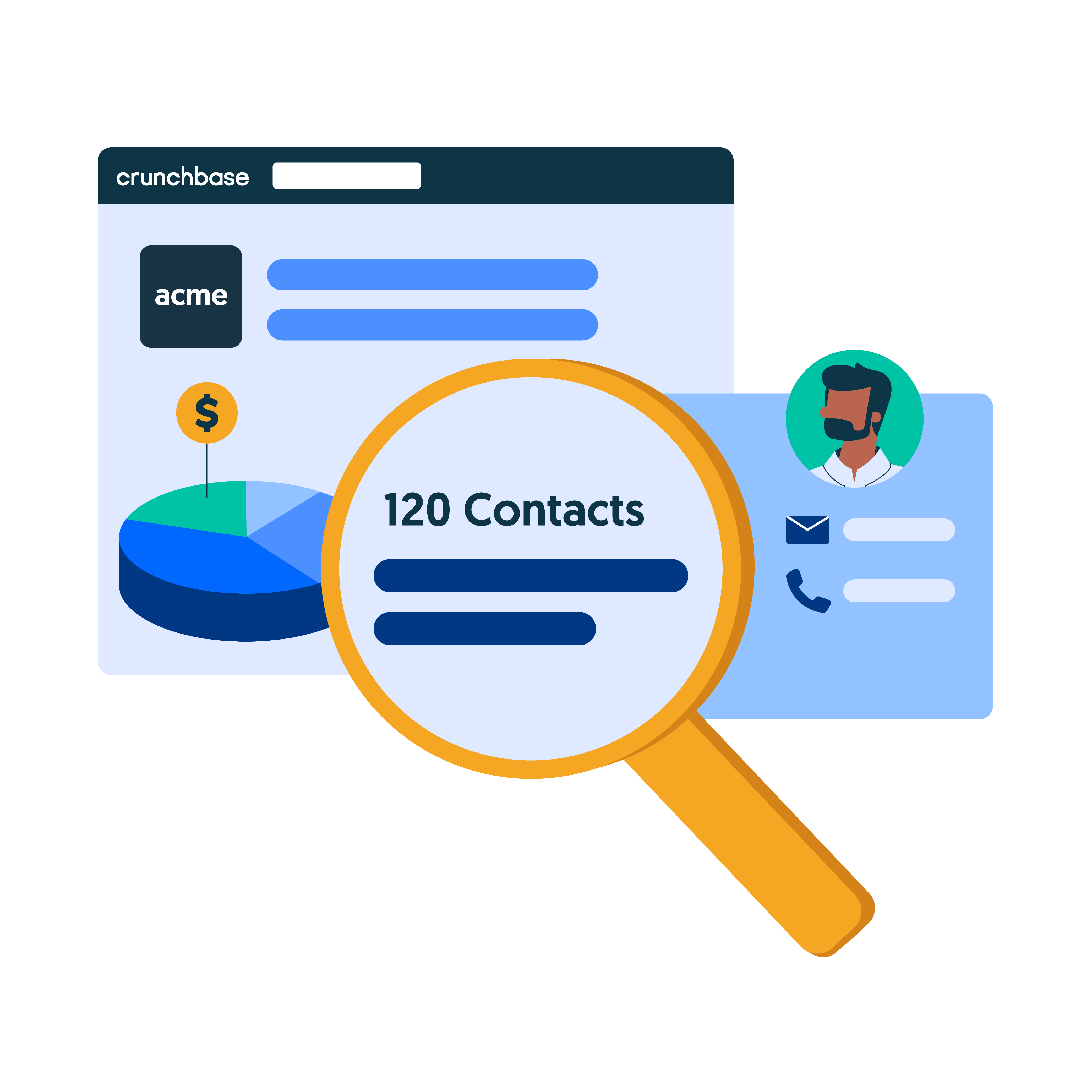While social media may not be the first thing that comes to mind when you think about sales prospecting, it has become an invaluable resource for many sales teams. With a vast amount of data available on platforms like LinkedIn, Twitter, Facebook and Instagram, reps can easily identify potential customers and connect with them in a personalized and meaningful way.
Social prospecting can help you reach a wider audience, build stronger relationships and close more deals. In this article, we dive into the world of social media prospecting and explore why it’s important, how to do it effectively and the techniques you can use to nurture and engage with prospects.
What is social prospecting?
Social prospecting (also known as social media prospecting or social selling) is the process of using social media platforms to identify and engage with potential customers. It involves leveraging the data available on social media to find individuals or companies that may be interested in your product or service.
You can use social media platforms to identify prospects who fit your ideal customer profile and develop targeted messaging to connect with them. Social prospecting allows you to engage with potential customers on a more personal level by building relationships that can lead to increased sales and revenue.
With the right approach, social media prospecting can be a highly effective way to expand your customer base and grow your business. According to LinkedIn, 78% of businesses that use social selling outperform those that don’t, and one in three B2B salespeople say that social prospecting has increased the number of leads they work with, according to CSO Insights.
The best social media prospecting channels
With so many social platforms to choose from these days, it can be tough to determine which will be the most effective for your business. Here are four of the best social media channels for prospecting, along with examples of how you can use them to identify new leads, engage with potential customers and build stronger relationships.

LinkedIn is one of the most useful social platforms for sales prospecting because it offers a number of features that make it easy to find and engage with prospects, including:
- The ability to search for potential customers who fit your ICP using filters such as job title, industry, company size and location. You can also use the alumni search tool to get a list of prospects who attended the same school you did so you can bond with them over a shared experience.
- A messaging feature that enables you to send direct messages to specific prospects. You can engage with prospects in a personalized way by sharing valuable insights and information that can help establish trust and build rapport.
- LinkedIn Groups, which allow you to contribute to conversations with like-minded professionals and potential clients in need of your services.

Although it’s not quite as targeted as LinkedIn, Twitter is still a valuable channel for sales prospecting. You can use Twitter to:
- Identify potential customers who are discussing topics related to your product or service by using hashtags, keywords and search filters to find relevant conversations.
- Engage with prospects in real-time to establish a connection and begin building a relationship. Twitter’s direct messaging feature provides a more private channel for communication, which allows you to continue the conversation and move prospects further down the sales funnel.
- Share relevant information and insights on your profile, which can help you position yourself as a thought leader in your industry and build credibility with potential customers.

Instagram is particularly useful for B2C sales reps in industries with very visual products, such as fashion, beauty and home goods. While it may not be the ideal platform for every sales team, those in certain industries can use it to build brand awareness and drive sales to:
- Showcase your products in a visually appealing way by using high-quality images and videos to demonstrate their features and benefits.
- Leverage hashtags and location tags to expand your reach and attract new followers who are interested in your product.
- Interact with prospects in a more personal and direct way with Instagram’s direct messaging feature. You can answer questions, address concerns and provide product recommendations.

Facebook is the world’s most widely used social media platform, with nearly 3 billion monthly active users. Facebook has a broader audience base compared to other social media platforms, and tends to be more popular with older people — close to 60% of its users are between the ages of 25 and 54, so it could be a particularly useful platform if your audience falls within this age range. It also offers a range of tools that can be used for prospecting, including:
- Business pages, which allow you to showcase your products and services, share updates and engage with followers.
- Industry-specific Facebook groups, where you can connect with potential customers, ask and respond to questions and share industry insights and advice.
4 tips for social prospecting
No matter which platform you choose to identify and engage your prospects, the following social selling tips will help you build pipeline and close more deals.
1. Optimize your social profile for your ideal customer
Before you can start optimizing your social media profiles, you’ll want to define your ICP to better understand the important characteristics that your most lucrative buyers share. Once you’ve identified your ideal customer’s industry, location, company size, revenue range and funding or IPO status, you should create a buyer persona.
Buyer personas are semi-fictional representations of your ideal customer. They are based on research and data about existing customers and outline the interests and pain points your customers face, which can be particularly useful when revamping your social profiles.
Once you’ve defined your ICP and buyer personas and know who you want to engage with, you can use the following tips to optimize your social media profiles:
- Use the right platforms: Determine which social media platforms your target audience uses the most, and focus on optimizing your profile on those platforms. For example, if your ideal customers are professionals, LinkedIn may be the best platform to focus on.
- Create a compelling bio: Your bio should quickly communicate what you do, who you serve and how you can help your ideal customers. Use keywords related to your industry and mention the benefits you offer.
- Use professional profile pictures and cover photos: Your profile picture and cover photo should be high-quality and look professional. Use images that showcase your brand and align with your target audience’s interests.
After you’ve finished tailoring your profile toward your ideal customer, you can start to focus on creating content and developing relationships with them.
2. Provide value with relevant content
An effective prospecting tactic is to grab your ideal customer’s attention by posting social media content that is informative, educational and relevant to them. This could involve sharing industry insights, posting tips and advice related to your product or service, or addressing common pain points that your prospects may face. Some ways of doing this include:
- Sharing content that matters to your audience: This kind of content can come in the form of ebooks, whitepapers or guides, and is informative and relevant to your industry or product. Ideally, this content should help your audience solve a problem or learn something new. You can demonstrate your expertise and build trust with your audience by sharing this kind of information.
- Providing social proof: Share testimonials, case studies and success stories to provide social proof that your product or service works. This type of content can also build credibility and establish trust with potential customers.
- Consistently posting and engaging with your audience: This will help you stay top of mind and build meaningful connections. Try to be consistent with your posting schedule and make sure you engage with your audience regularly. LinkedIn’s Sales Blog recommends posting a variety of content — including articles, resources, quotes and infographics — at least three to four times per day.
By consistently providing value and engaging with your prospects, you’ll not only generate leads and drive sales, but also build a loyal customer base and a strong brand reputation.
3. Build meaningful connections
The best way to establish credibility and build relationships on social media is to establish a strong personal brand and show what you are passionate about. Remember to be authentic, transparent and consistent in the way you present your brand on your social channels. Some ways to do this include:
- Showing your personality: Share stories and photos from your life to build a personal connection with your prospects and show them who you are. This can help humanize your brand and make you more relatable.
- Engaging with your audience: Respond to comments and messages promptly and in a friendly, helpful manner. You can also comment on posts by people in your target audience and share their content to get your company on their radar.
- Building your network: Connect with your ideal customers and others in your industry. Joining relevant groups and participating in discussions is a good way to meet others in your industry and demonstrate your knowledge.
By focusing on building relationships rather than just making sales, you can create a long-lasting and loyal customer base.
4. Create effective messaging that resonates
The first step toward building impactful messaging is to have a clear understanding of your target audience’s pain points, needs and desires. Once you’ve got those down and have identified prospects you’d like to connect with, you can start conducting personal outreach on social media that addresses their pain points and offers solutions to their problems. Here are a few ways to do this:
- Be specific: Personalization is key when it comes to messaging prospects on social media — this means going above and beyond name and job title. For example, you can congratulate them on a recent funding round or new position, or compliment them on a recent article or LinkedIn post they wrote. The bottom line is to show that you genuinely care about the success of their business and have done your research, rather than just copying and pasting cookie-cutter messages.
- Find common ground: It’s easier to connect with prospects and personalize your outreach when you have something in common, and the thing you share can help you start a conversation in a natural way. Fortunately, LinkedIn makes it easy to use filters to search for details such as professional experience, schools attended, LinkedIn groups, local area and shared connections.
- Focus on the benefits: It’s important to focus on the benefits of your product or service and how it can help your potential customers, rather than just the features. Try to use clear and concise language that is easy to understand and avoid jargon or buzzwords.
By creating messaging that resonates with prospects on social media, you can increase engagement, build trust and ultimately drive more sales.
*Tip — You can search Crunchbase to discover a company’s latest funding round, new hires and more. Once you’ve learned the information you need to personalize your outreach, you can leverage Crunchbase data when you reach out to your prospects on social media.
Learn more about Crunchbase’s all-in-one prospecting platform here or talk to sales if you’re looking for a solution for your entire team.





